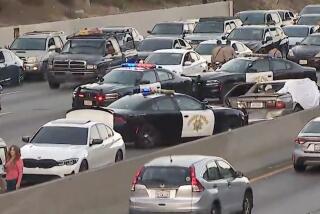Solutions to Freeway Shootings Are Elusive
- Share via
When a neighborhood is hit by burglaries, residents can form a neighborhood watch. If drunk driving becomes a problem, officials can set up DUI checkpoints. But the California Highway Patrol is struggling to find ways to curb the shootings on local freeways that total 21 so far this year, including two within about 40 minutes Thursday.
The shootings have left four men dead.
A month ago, the CHP announced measures designed to address the shootings. It formed a task force with local law enforcement agencies. Authorities talked about upgrading Caltrans camera systems to monitor traffic and record license plates, providing potential clues for investigators.
But officials said they don’t know if or when they would have enough money to buy or maintain either an expanded camera system or plate-reading technology.
CHP also boosted patrols, including some using unmarked pickup trucks and compact cars, last month as part of a crackdown.
Officials said Friday, however, that those extra units are used only sporadically because the agency doesn’t have the resources for full-time operations.
Investigators continue to probe the shootings but have not made any arrests.
“You can’t prevent them,” said CHP Assistant Chief Art Acevedo. “All you can do is try to deter them.”
Acevedo said he believes the incidents -- which have spread across Los Angeles, Riverside and Orange counties -- are unrelated. No common patterns have emerged.
Some of the shootings, Acevedo speculated, are gang-related and some are copycats. But he characterized most as spontaneous “crimes of passion.”
“People lose their minds,” he said. “They get angry, short-tempered, and the next thing you know they discharge a firearm.”
The first of the freeway shootings occurred March 12, when a 26-year-old Fontana man was fatally shot in the head on the Costa Mesa Freeway in Tustin.
The next was 17 days later. The pace picked up with an April 22 fatality on the Pomona Freeway in San Bernardino and four shootings from April 30 to May 2.
Until Thursday, the increased CHP patrols had a “calming effect” on the roadways, Acevedo said.
“I get paged when we have shootings on the freeway, and my pager, other than yesterday, has been very quiet,” he said Friday.
A car-to-car shooting on the Century Freeway at 1:35 p.m. Thursday left a Gardena man slightly wounded, when five shots were fired from a dark blue sedan and a bullet grazed the back of his head. The man was able to drive off the freeway after he realized he’d been wounded.
The motive for the shooting is unknown, Los Angeles County sheriff’s detectives said.
In an unrelated incident about 40 minutes later, an ambulance came under fire on the southbound Long Beach Freeway near Bell Gardens.
A paramedic for a private ambulance told authorities he heard a “pop” near Florence Avenue.
After getting off the freeway, he found a bullet hole in the right rear of the vehicle, which apparently was not carrying a patient, said CHP Sgt. Paul Medeiros. There were no suspects and the CHP is investigating the incident. “There’s no indication it was related to the shooting on the 105,” Medeiros said.
The number of freeway shootings has been declining over the last few years, Acevedo said.
So far this year, 12 freeway shootings have been reported in which a person or vehicle was hit by gunfire within Los Angeles, according to the CHP and Los Angeles Police Department. That is one fewer than at this point last year.
In 2004, 36 freeway shootings were reported within Los Angeles, and one resulted in a death. In 2003, four people were killed in 46 incidents.
As part of the task-force effort, LAPD has agreed to respond to the next freeway-shooting fatality with its robbery and homicide unit, which will handle the investigation, said LAPD Capt. Al Michelena.
But investigating freeway shootings has unique challenges.
“Obtaining evidence, lack of witnesses, the random act, lack of motive and lack of relationship between victim and suspect makes it very difficult to solve these,” Michelena said.
He thinks the answer lies in technology. “Very few of these are solved,” he said. “But I think we’re going to catch up with this using technology.”
*
Times staff writer Wendy Thermos contributed to this report.
More to Read
Sign up for Essential California
The most important California stories and recommendations in your inbox every morning.
You may occasionally receive promotional content from the Los Angeles Times.













